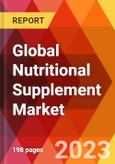The global nutritional supplement market, valued at USD 167.94 billion in 2022, is projected to escalate to USD 301.41 billion by 2030, registering a CAGR of 7.91% over the forecast period. Nutritional supplements, designed to address specific nutritional deficiencies, promote health, and assist certain physiological functions, have seen a surge in demand. Available in various forms like capsules, tablets, powders, liquids, and gummies, these supplements cater to a broad spectrum of nutritional needs.The global nutritional supplement market, valued at USD 167.94 billion in 2022, is projected to escalate to USD 301.41 billion by 2030, registering a CAGR of 7.91% over the forecast period.
Growth Influencers:
The increasing demand for sports nutritional supplements and dietary supplements, fueled by a rise in fitness and bodybuilding enthusiasts, has significantly bolstered the market. The youth demographic is a major consumer base for these supplements. Brands like Optimum Nutrition have responded to this demand with new product launches.The growing need to fill the nutrition gap due to diminishing food quality has also propelled the market. Modern dietary habits and lifestyle choices often result in nutrient deficiencies, creating a demand for reliable, convenient nutritional supplements. Companies like Abbott have capitalized on this need by launching new formulations designed to boost muscle and bone health.
Segments Overview:
The global nutritional supplement market is segmented based on product type, ingredients, form, age group, end-user, and distribution channel.By Product Type
- Dietary Supplements
- Beverages
- Functional Nutrition
- Infant & Maternal Nutrition
- Medical Nutrition
- Sports Supplements
- Others
By Ingredients
- Vitamins
- Botanicals
- Minerals
- Proteins & Amino Acids
- Fibers & Specialty Carbohydrates
- Omega Fatty Acids
- Others
By Form
- Capsule
- Powder
- Tablet
- Liquid
- Others
By Age Group
- Infants
- Adults
By End user
- Energy & Weight Management
- General Health
- Bone & Joint Health
- Gastrointestinal Health
- Immunity
- Cardiac Health
- Diabetes
- Anti-cancer
- Others
By Distribution Channel
- Hypermarkets & Supermarkets
- Pharmacy Stores
- Online Channels
- Others
Regional Overview:
By region, the market is divided into North America, Europe, Asia Pacific, Middle East and Africa, and South America.North America
- US
- Canada
- Mexico
Europe
- Western Europe
- UK
- Germany
- France
- Italy
- Spain
- Rest of Western Europe
- Eastern Europe
- Russia
- Poland
- Rest of Eastern Europe
Asia Pacific
- China
- India
- Japan
- Australia + New Zealand
- South Korea
- ASEAN
- Rest of Asia Pacific
Middle East & Africa
- UAE
- Saudi Arabia
- South Africa
- Rest of Middle East & Africa (MEA)
South America
- Brazil
- Argentina
- Rest of South America
Competitive Landscape:
The global nutritional supplement market hosts strong competitors like Abbott Laboratories, Archer Daniels Midland, Amway, Arkopharma Laboratoires Pharmaceutiques, Bayer, Bionova Lifesciences, Carlyle Group, Glanbia, GlaxoSmithKline, Pfizer, and others. These companies have strategized with new product launches, meeting FD standards, and other compliance measures to maintain their market dominance. In June 2022, upon meeting the initial FD standards, Abbott Nutrition resumed the production of infant formula at its facility located in Sturgis, Michigan. The initial production line included EleCare and various other specialty and metabolic medicines. Early 2023 saw a surge in the popularity of Man Matter biotin hair gummies, closely followed by the widely accepted Bodywise hair gummies, which offered a customized supplement consumption schedule.Table of Contents
Chapter 1. Research Framework
Chapter 2. Research Methodology
Chapter 4. Global Nutritional Supplement Market Overview
Chapter 5. Global Nutritional Supplement Market Analysis, By Product Type
Chapter 6. Global Nutritional Supplement Market Analysis, By Ingredient
Chapter 7. Global Nutritional Supplement Market Analysis, By Form
Chapter 8. Global Nutritional Supplement Market Analysis, By Age Group
Chapter 9. Global Nutritional Supplement Market Analysis, By End-Use
Chapter 10. Global Nutritional Supplement Market Analysis, By Distribution Channel
Chapter 11. Global Nutritional Supplement Market Analysis, By Region/Country
Chapter 12. North America Nutritional Supplements Market Analysis
Chapter 13. Europe Nutritional Supplements Market Analysis
Chapter 14. Asia Pacific Nutritional Supplements Market Analysis
Chapter 15. Company Profile (Company Overview, Financial Matrix, Key Product landscape, Key Personnel, Key Competitors, Contact Address, and Business Strategy Outlook)
Companies Mentioned (Partial List)
A selection of companies mentioned in this report includes, but is not limited to:
- Abbott Laboratories
- Archer Daniels Midland
- Amway
- Arkopharma Laboratoires Pharmaceutiques
- Bayer
- Bionova Lifesciences
- Carlyle Group
- Glanbia
- GlaxoSmithKline
- Nu Skin Enterprises
- Pfizer
Table Information
| Report Attribute | Details |
|---|---|
| No. of Pages | 198 |
| Published | June 2023 |
| Forecast Period | 2022 - 2030 |
| Estimated Market Value ( USD | $ 167.94 Billion |
| Forecasted Market Value ( USD | $ 301.41 Billion |
| Compound Annual Growth Rate | 7.9% |
| Regions Covered | Global |








